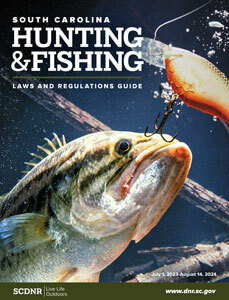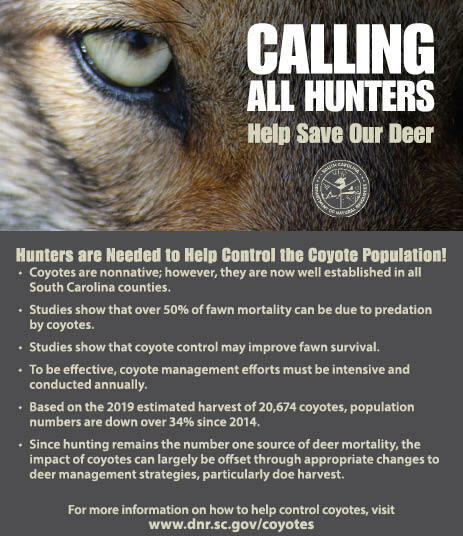Feral Hog, Coyote & Armadillo Regulations
Feral Hogs
Feral or wild hogs occur in the wild in every county of the state. They compete directly with native wildlife species, damage plants, agricultural crops, and threaten public and livestock health. It is illegal to remove a hog from the wild alive. It is illegal to transport any live swine on public roads or waterways unless the swine have an official form of identification approved by the State Veterinarian or a document such as a receipt, bill of sale, or similar document showing the quantity of swine being transported and the name of the producer or dealer from whom the live swine were purchased or received. Live swine transported without identification are presumed to have been taken from the wild and in violation of law. (47-4-65, 50-16-25).
Feral hogs may be trapped year-round on private lands without a license or permit. Cable restraints (snares) are not a legal trap for use on land, so hog traps utilizing any kind of snare are illegal (50-11-2460). Individuals trapping hogs are encouraged to use traps that provide a means for deer or bear to escape. Any deer or bear caught in a trap used to capture hogs must immediately be released. All trapping laws regarding trap identification, permission to trap, and trap check requirements apply (see Trapping & Commercial Fur Harvesting).
Swine brucellosis
Swine brucellosis is caused by a bacteria and is primarily a reproductive tract disease in wild pigs that can be transmitted to humans. Infections are manifested by flu-like symptoms including fever, headaches, muscle and joint soreness and weakness. The fatality rate in humans is very low, but the disease often is prolonged and debilitating. Humans have contracted swine brucellosis from handling and dressing wild swine. This disease is present in many wild hog populations in SC. Persons dressing wild swine should take the following precautions: 1) use disposable rubber gloves and protective eyeglasses while dressing the carcass, 2) minimize handling of the reproductive tracts of both sexes, 3) dispose of waste parts by burying or burning, 4) clean up with hot water and soap after processing, and 5) cook meat thoroughly to 160° F prior to eating.
Hunting Feral Hog, Coyotes, & Armadillos
A hunting license is required, however there is no closed season on hunting feral hogs, coyotes, and armadillos on private land statewide during daylight hours. The use of bait and electronic calls is legal on private lands statewide.
Feral hogs, coyotes and armadillos may be hunted at night on a registered property on which a person has a lawful right to hunt, using any legal firearm, bow and arrow, or crossbow. This includes the use of bait, electronic calls, artificial lights, and night vision devices. A property may be registered online on the SCDNR website (
No feral hog, coyote, or armadillo hunting with firearms is allowed at night within 300 yards of a residence without the permission of the occupant; however, this does not apply to a landowner hunting his own land, or hunting under the authority of a SCDNR depredation permit. No shooting or attempting to shoot from, on, or across any public paved road.
In order to assess the night hunting program, the person registering the property must report to the department the number of feral hogs, coyotes, and armadillos taken under the provisions of this section within thirty days following the end of the twelve month registration period, or prior to registering the property again. Properties for which reports have not been submitted will not be registered again until such time that reports are submitted (50-11-715).
Feral hog, coyotes, and armadillos cannot be hunted at night on WMA lands, but can be hunted during the day on WMAs where feral hog, coyote, and/or armadillo hunting is allowed. On WMA lands, weapons used to hunt feral hog, coyotes, and armadillos are limited to the weapon(s) that are allowed for the current open season on the WMA unless otherwise specified — see WMA seasons listing in the Game Zones sections, and see Hog Hunting Seasons for WMAs & Heritage Preserves. The use of electronic calls for feral hog and coyote hunting is permitted statewide on WMA lands.
Dog hunting for feral hogs and coyotes is allowed year-round on private lands statewide. Deer may not be hunted with dogs on any lands in Game Zones 1 & 2. On WMA lands in Game Zones 1 & 2, feral hogs and coyotes may not be hunted with dogs during still gun and muzzleloader hunts for deer or bear. Dogs can be used to hunt and bay hogs at night on private lands as long as the hunter(s) complies with the property registration requirement. Dogs can be used on WMA lands to hunt feral hogs only during special hunts with dogs – see Hog Hunting Seasons for WMAs & Heritage Preserves.
The possession or transport of live coyotes is allowed only by licensed trappers during the trapping season and thirty days after the close of the trapping season, or by special permit from SCDNR. Importation of coyotes into the state is a violation of both State and Federal law.
Coyote Harvest Incentive Program
The Coyote Harvest Incentive Program was established with a 2016 Legislative budget proviso, directing SCDNR to annually tag and release four coyotes per game zone (16 total). Initially the reward was a lifetime hunting license, but beginning in July of 2023, the reward for reporting a tagged coyote will be $3,000 to the hunter/trapper reporting the tagged coyote, or their designee. No hunter/trapper may collect the reward on more than two coyotes per fiscal year. Only SCDNR reward tags are eligible. Employees of SCDNR, members of the General Assembly, and their immediate families are not eligible to receive a reward. This incentive program has continued each year since 2016. At the time of this printing, 112 SCDNR-tagged coyotes have been released with approximately half still remaining.


